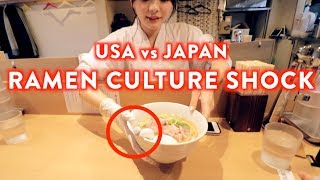Watch

This is in the US recently. I went to a ramen shop in San Francisco, in a Little Tokyo. Ramen shop itself was quite decent, but I kind of had a ramen culture-shock experience in the shop. I've lived in Japan for more than 15 years now. And I travel to the US once in a while but not that often. And I generally don't eat ramen when I go to the US. So, when I went there, I was completely surprised about how the ramen shops are so different. And to be fair, I know that all ramen shops are not like this in the US, but I wanted to use this specific ramen shop as an example.
Oh, and before I start, if you want to help support the channel, then definitely check out my Tokyo merch. If you want to see what I'm doing daily, then check out my Instagram account. The first thing I want to discuss is the overall experience. So, I discovered in the US, that eating ramen is so much more of a friend's and family's social experience. Customers are there to eat, drink, and socialize. So, you see a lot more tables designed for groups. In fact, you even see quite a few kids. And thus, you have a dining experience that caters to people spending more time in the ramen shop. Whereas ramen shops in Japan, it's quite different.
Ramen shops are considered fast foods joints. You're meant to get in and get out as quick as possible as there's limited sitting in most shops. Also, you don't find many tables, but rather counter seats are most common. Another thing that's quite interesting is the queueing or lining up process. In the US, there seems to be electronic reservation system now at some spot. If that's not available, it's common to put your name on the waiting list until your seated, so people are generally standing around in front of the ramen shop until their names are called. Whereas in Japan, there is no reservation system or waiting list.
You arrive at the shop, if all the seats are filled, you just wait in a single file line. It's old school, literally, like when you were in first grade waiting at the lunch line. It's first come, first serve. Simple. Now, ordering is a lot different in both countries. All right. The soup just came. In the US, it's very much your standard restaurant feel. You're handed a full menu, and a few moments later, a waiter will come and take your order. While in Japan, you'll usually find a ticket vending machine at the entrance. You press a button, a ticket pops out, and then you walk over your tickets to the ramen cook or server. Minimal interaction, and you get exactly what you ordered.
Also worth noting is how you pay at the ramen shops. In the US, it's pretty standard. At the end of the meal, you pay by cash or credit card. Don't forget to add a minimum 18% to 20% tip, and you're all good to go. In Japan, you actually pay upfront. Remember that ticketing machine at the entrance, before it pops out a ticket, you've got to pay to play. Again, minimal interaction, and you can leave right after you finish your bowl of ramen. And the thing I personally appreciate the most; no tip. Now, this one is interesting to me, is the menu options because they're so different. In the US, there just seems to be way more options on the menu.
I saw items such as katsu curry, tempura, steamed pork bun. On top of that, there was an entire page dedicated to drinks alone. Talk about creating a social atmosphere. Oh yeah, there's even vegan options with the all the ingredients listed. But don't expect any of this in Japan. I don't know, but I think people in the US really enjoy appetizers and the side menu. When I was in the US, the table ordered a salad and even a sashimi bowl. Although it's a completely different type of food, the US customer-base seems to really enjoy having a variety of food with their ramen.
On the other hand, Japan ramen shops tend to focus on the ramen and the ramen alone, as well as just trying to perfect that one bowl of ramen. And in my experience, when Japanese people want to eat ramen, they go to ramen shops. And i f they want to eat sushi, they just go to sushi restaurants. Now, this one caught me off guard because I've been in Japan so long, it is the takeaway. I noticed in the US that some people didn't finish their ramen. I thought they were just let it go to waste. Yes, I'm aware that there is a takeout system in the US, but I didn't think people would actually take home their unfinished bowl of noodles.
In Japan, the takeaway system is rare in most restaurants but literally non-existing at ramen shops. For Japanese people, the idea of taking half-eaten noodles home is strange and almost a disgusting practice since the noodles would be soaking in broth many hours after you take it home, the noodles would be soggy and not very appetizing. I don't know though.. I've never really had leftover ramen noodles. Wonder what it tastes like. Finally, when you're finishing up the ramen, it's the cleanup process. Well, it seems pretty standard in the US; you finish your meal and the waiter takes all your plates. In Japan, on the other hand, because most of the time you're sitting at the counter, the ramen cook is on the other side of the counter.
It's quite difficult for the ramen cook to reach down and get the bowl to clean up. So, it's common courtesy when you finish, place your bowl, used napkins and glass on top of the counter. This allows the chef to easily clean up, and the next customer can take your spot straight away. So that's basically it. If I missed anything let me know in the comments. If you don't live in the US or Japan, let me know what your country does because I really like to know. Again, for me, each country has their own way of doing things. One country is not better than the other. They just do it differently. It's a lot because of the culture.
With that all said, if you want to help support the channel, check out my Tokyo merch. And if you want to see more about Japan guides, I release a video every Saturday morning, Japan time. So hit that subscribe button and the bell button. I'll catch you guys in the next one.
Check your understanding
Vocabulary Game
Listen
More Vocabulary
Grammar
More Listening
Read
Paolo de Guzman: In this video, we’re going to explore the differences in ramen shops between the US and Japan.
This is in the US recently. I went to a ramen shop in San Francisco, in a Little Tokyo. Ramen shop itself was quite decent, but I kind of had a ramen culture-shock experience in the shop. I’ve lived in Japan for more than 15 years now. And I travel to the US once in a while but not that often. And I generally don’t eat ramen when I go to the US. So when I went there, I was completely surprised about how the ramen shops are so different. And to be fair, I know that all ramen shops are not like this in the US, but I wanted to use this specific ramen shop as an example.
Oh, and before I start, if you want to help support the channel, then definitely check out my Tokyo merch. If you want to see what I’m doing daily, then check out my Instagram account.
The first thing I want to discuss is the overall experience. So I discovered in the US, that eating ramen is so much more of a friend’s and family’s social experience. Customers are there to eat, drink, and socialize. So, you see a lot more tables designed for groups. In fact, you even see quite a few kids. And thus, you have a dining experience that caters to people spending more time in the ramen shop.
Whereas ramen shops in Japan, it’s quite different. Ramen shops are considered fast foods joints. You’re meant to get in and get out as quick as possible as there’s limited seating in most shops. Also, you don’t find many tables, but rather counter seats are most common.
Another thing that’s quite interesting is the queuing or lining up process. In the US, there seems to be electronic reservation system now at some spot. If that’s not available, it’s common to put your name on the waiting list until your seated, so people are generally standing around in front of the ramen shop until their names are called.
Whereas in Japan, there is no reservation system or waiting list. You arrived at the shop, if all the seats are filled, you just wait in a single-file line. It’s old school, literally, like when you were in first grade waiting at the lunch line. It’s first come, first serve. Simple.
Now, ordering is a lot different in both countries. The soup just came. In the US, it’s a very much of standard restaurant feel. You’re handed a full menu, and a few moments later, a waiter will come and take your order.
While in Japan, you’ll usually find a ticket vending machine at the entrance. You press a button, a ticket pops out, and then you walk over your tickets to the ramen cook or server. Minimal interaction, and you get exactly what you ordered.
Also worth noting is how you pay at the ramen shops. In the US, it’s pretty standard. At the end of the meal, you pay by cash or credit card. Don’t forget to add a minimum 18% to 20% tip, and you’re all good to go. In Japan, you actually pay upfront. Remember that ticketing machine at the entrance, before it pops out a ticket, you’ve got to pay to play. Again, minimal interaction, and you can leave right after you finish your bowl of ramen. And the thing I personally appreciate the most; no tip.
Now, this one is interesting to me, is the menu options because they’re so different. In the US, there just seems to be way more options on the menu. I saw items such as katsu curry, tempura, steamed pork bun. On top of that, there was an entire page dedicated to drinks alone. Talk about creating a social atmosphere. Oh yeah, there’s even vegan options with the all the ingredients listed.
But don’t expect any of this in Japan. I don’t know, but I think people in the US really enjoy appetizers and the side menu. When I was in the US, the table ordered a salad and even a sashimi bowl. Although it’s a completely different type of food, the US customer base seems to really enjoy having a variety of food with their ramen.
On the other hand, Japan ramen shops tend to focus on the ramen and the ramen alone, as well as just trying to perfect that one bowl of ramen. And in my experience, when Japanese people want to eat ramen, they go to ramen shops. And if they want to eat sushi, they just go to sushi restaurants.
Now, this one caught me off guard because I’ve been in Japan so long, it is the takeaway. I noticed in the US that some people didn’t finish their ramen. I thought they were just gonna let it go to waste. Yes, I’m aware that there is a takeout system in the US, but I didn’t think people would actually take home their unfinished bowl of noodles. In Japan, the takeaway system is rare in most restaurants but literally non-existing at ramen shops. For Japanese people, the idea of taking half-eaten noodles home is strange and almost a disgusting practice since the noodles would be soaking in broth many hours after you take it home, the noodles would be soggy and not very appetizing. I don’t know though. I’ve never really had leftover ramen noodles. Wonder what it tastes like.
Finally, when you’re finishing up the ramen, it’s the cleanup process. Well, it seems pretty standard in the US; you finish your meal and the waiter takes all your plates. In Japan, on the other hand, because most of the time you’re sitting at the counter, the ramen cook is on the other side of the counter. It’s quite difficult for the ramen cook to reach down and get the bowl to clean up. So, it’s common courtesy when you finish, place your bowl, used napkins and glass on top of the counter. This allows the chef to easily clean up, and the next customer can take your spot straight away.
So that’s basically it. If I missed anything let me know in the comments. If you don’t live in the US or Japan, let me know what your country does because I really like to know. Again, for me, each country has their own way of doing things. One country is not better than the other. They just do it differently. It’s a lot because of the culture. With that all said, if you want to help support the channel, check out my Tokyo merch. And if you want to see more about Japan guides, I release a video every Saturday morning, Japan time. So hit that subscribe button and the bell button. I’ll catch you guys in the next one.
1155 Words









Comments
0 comments